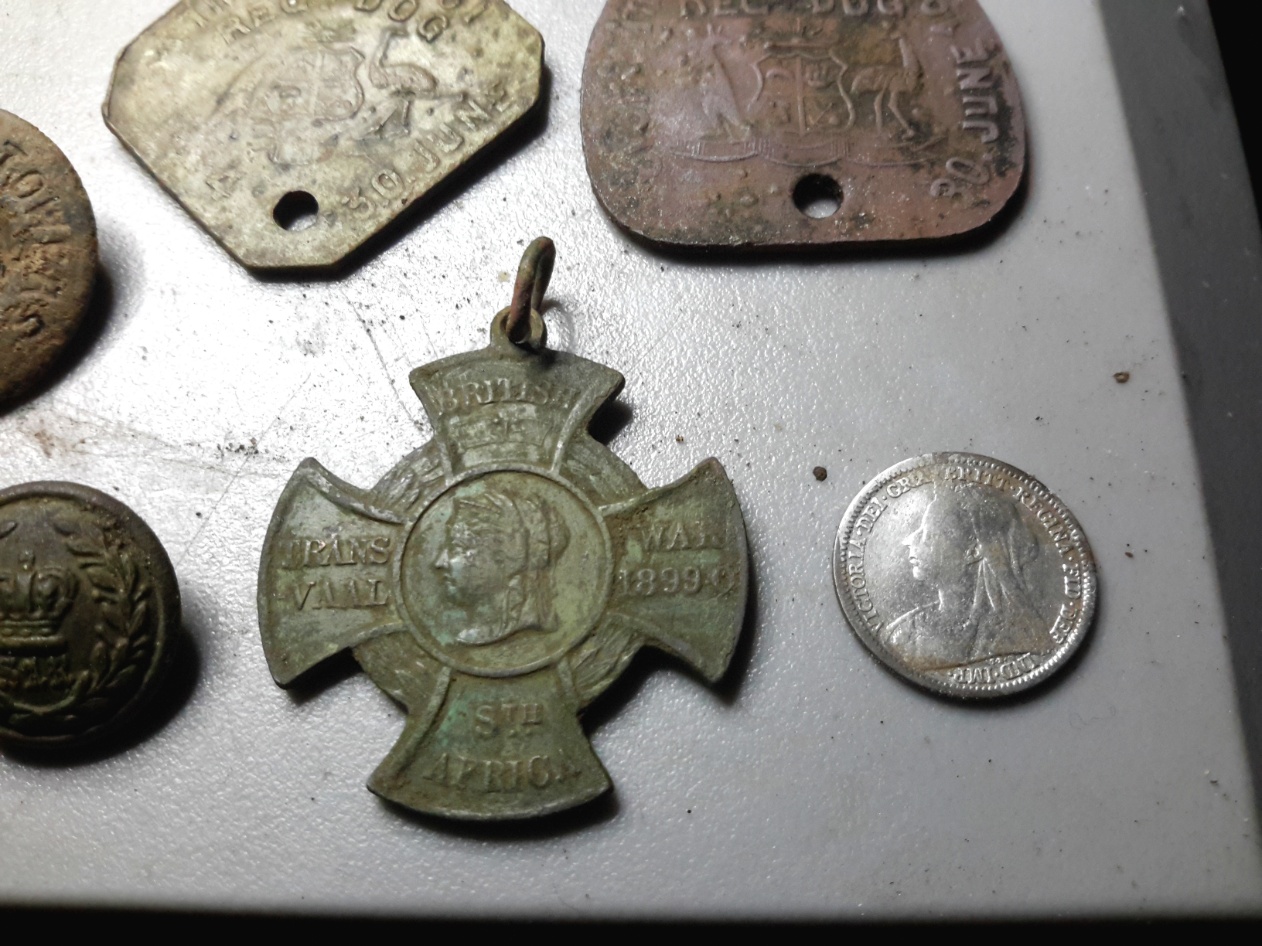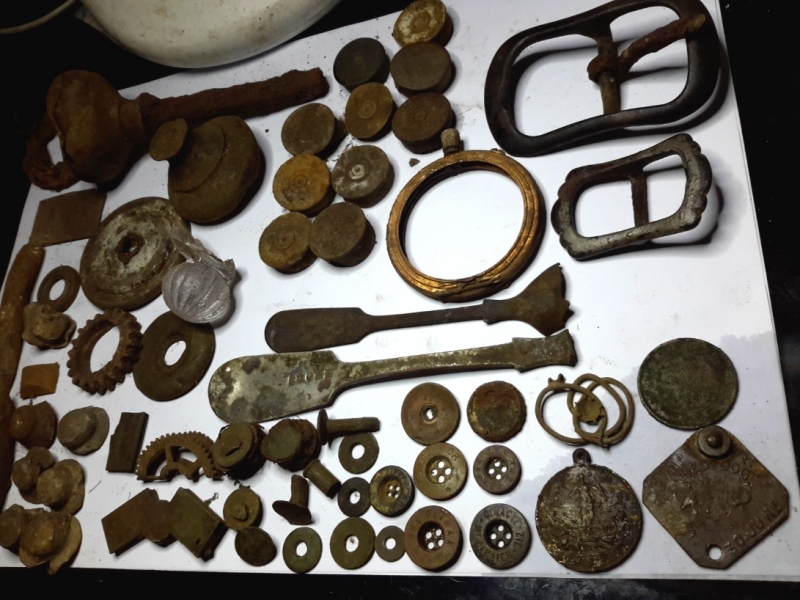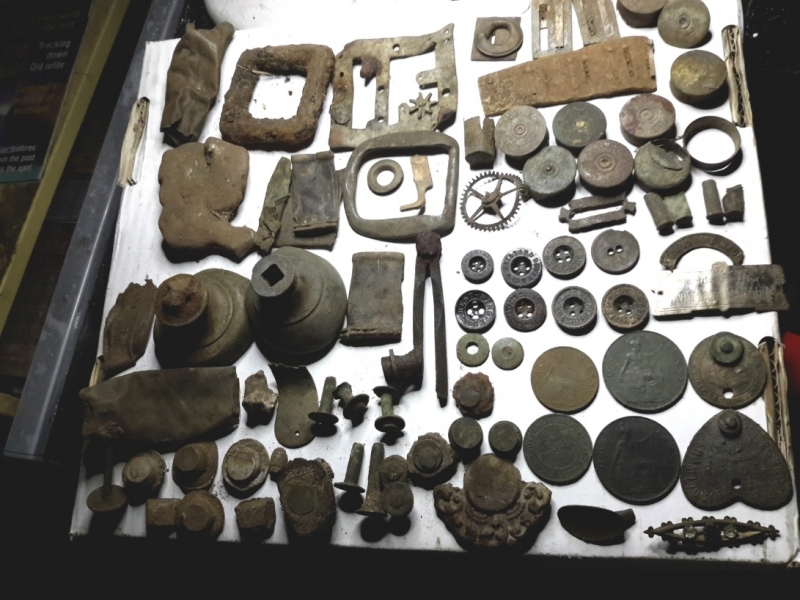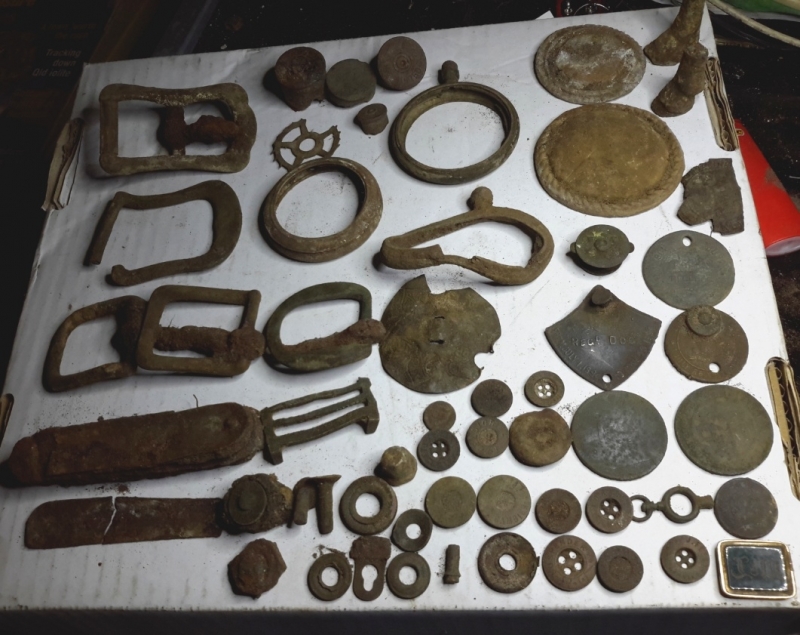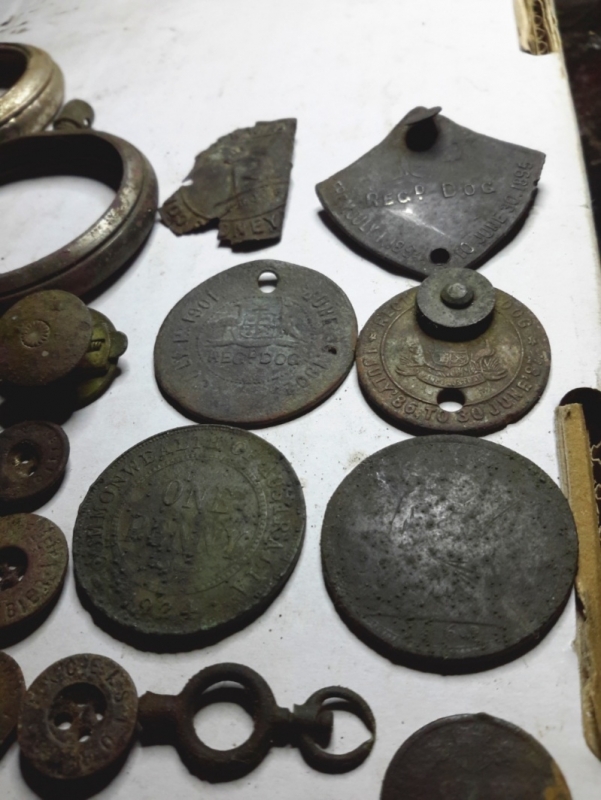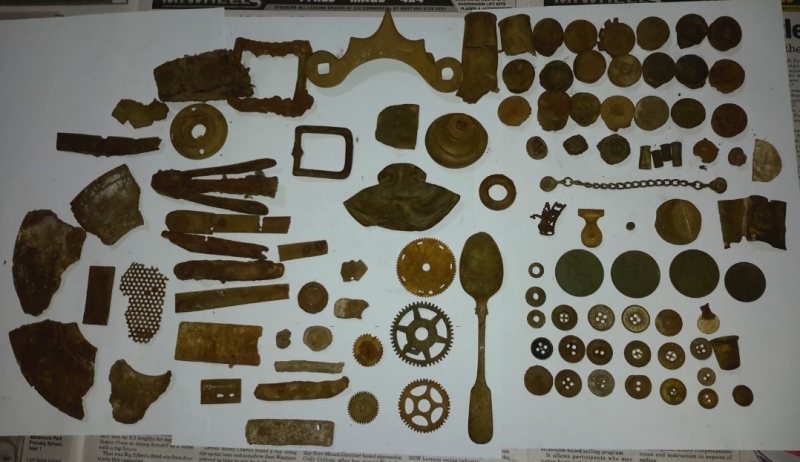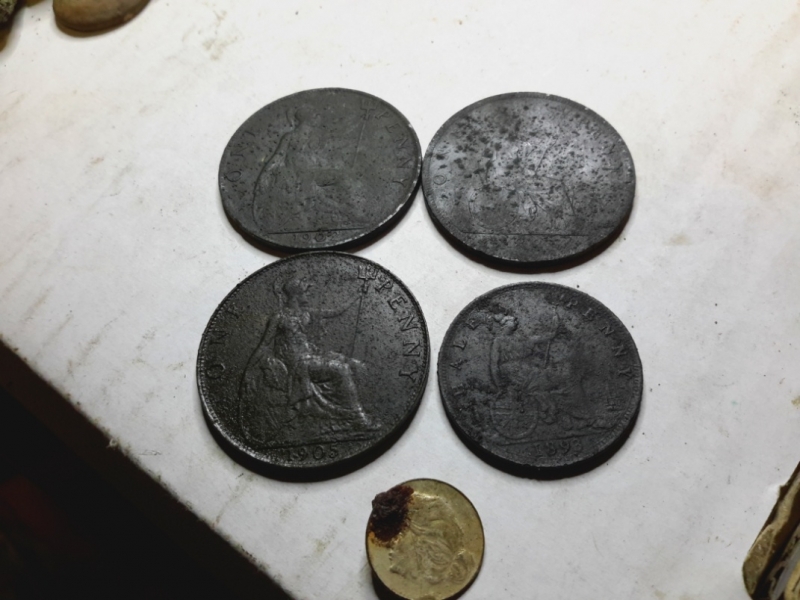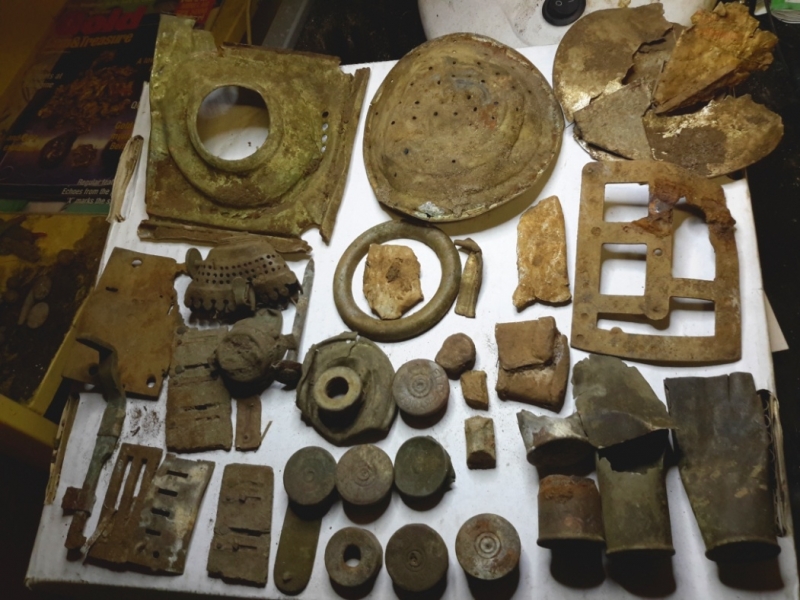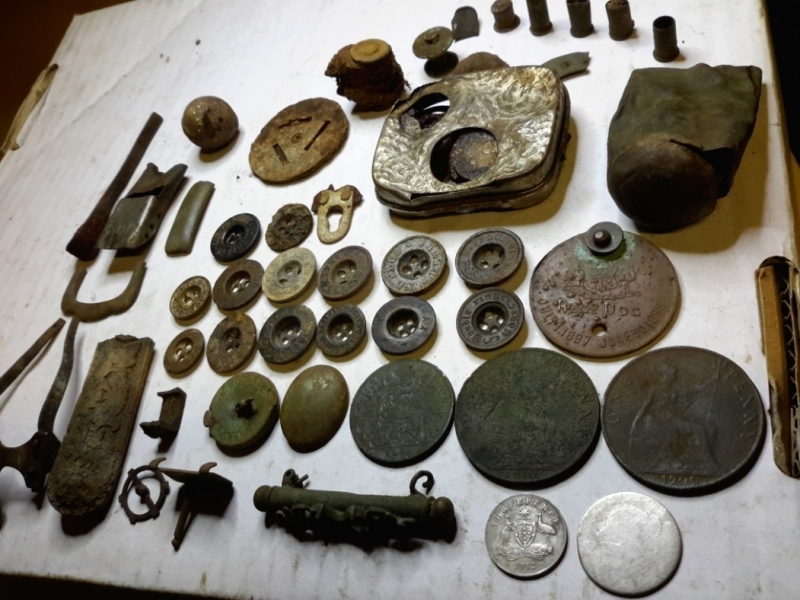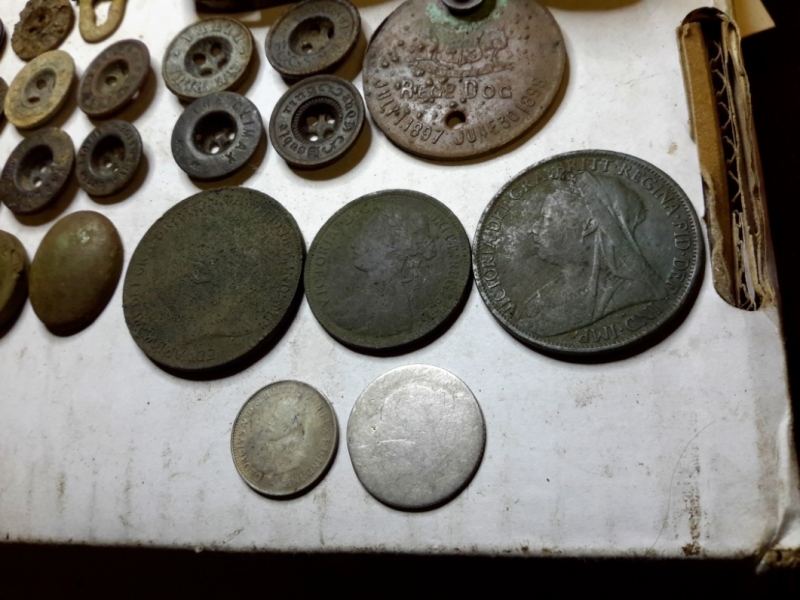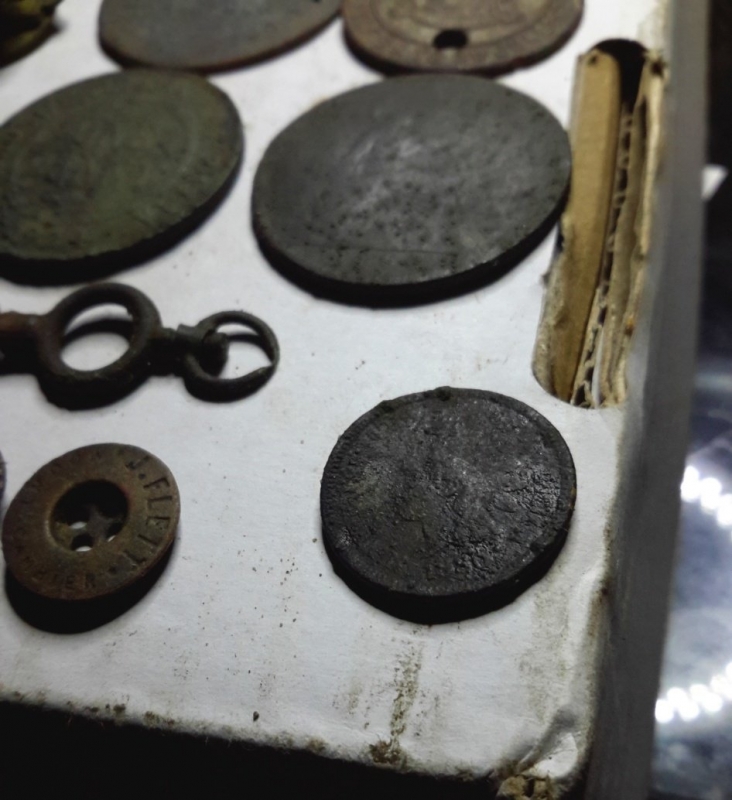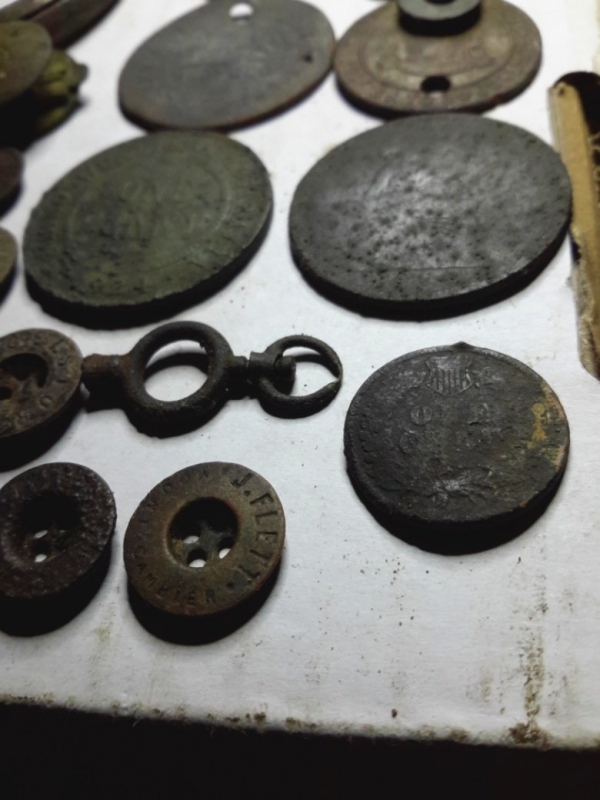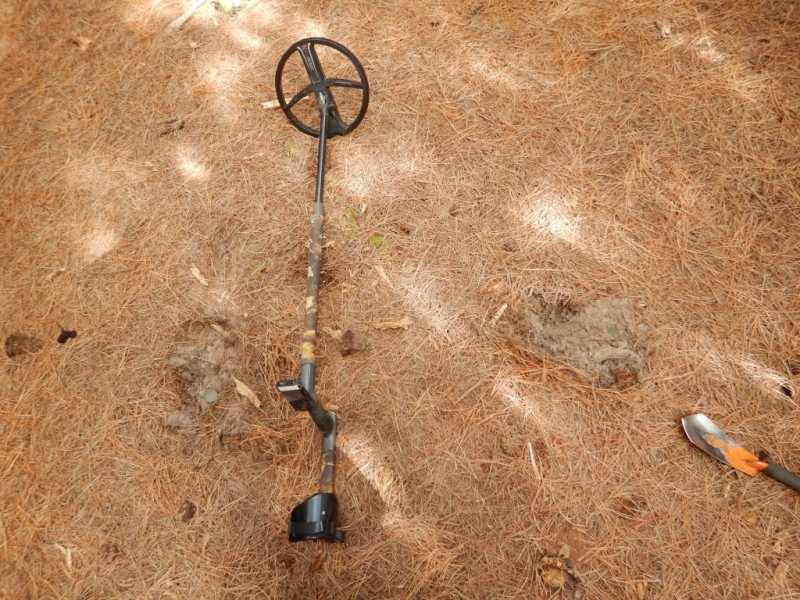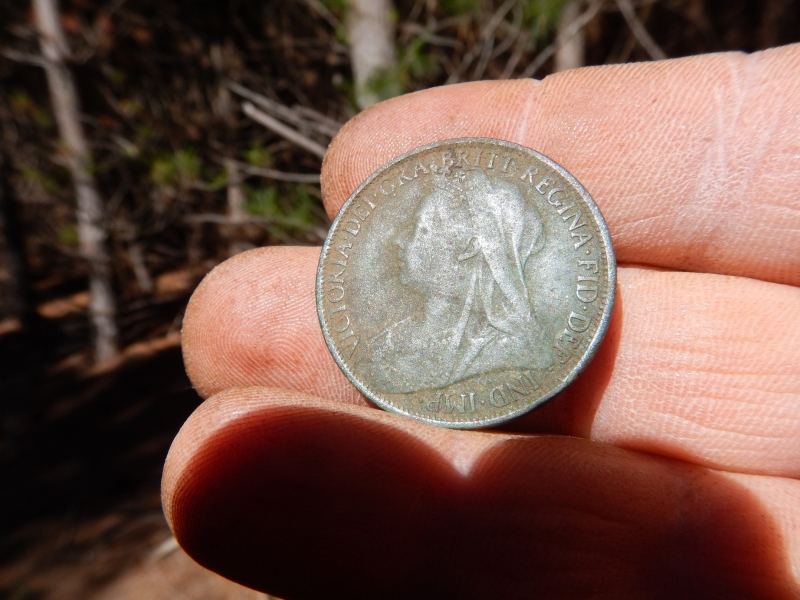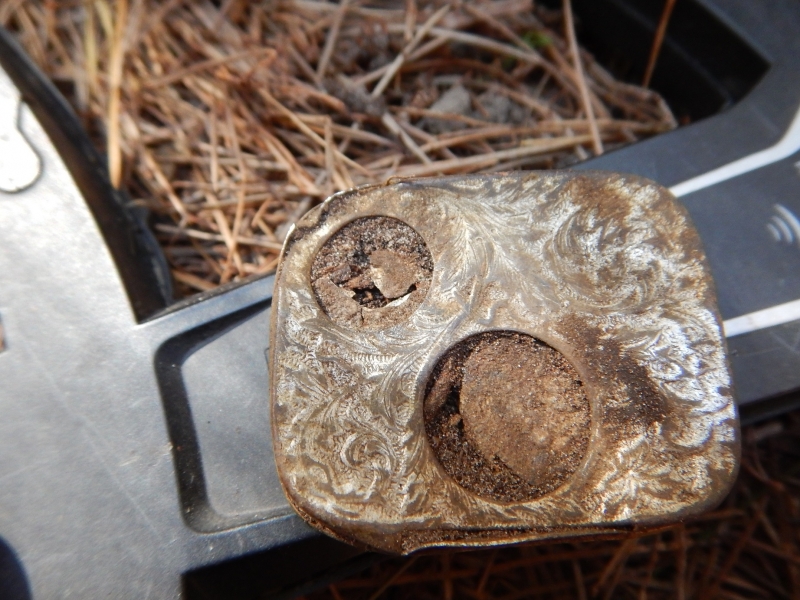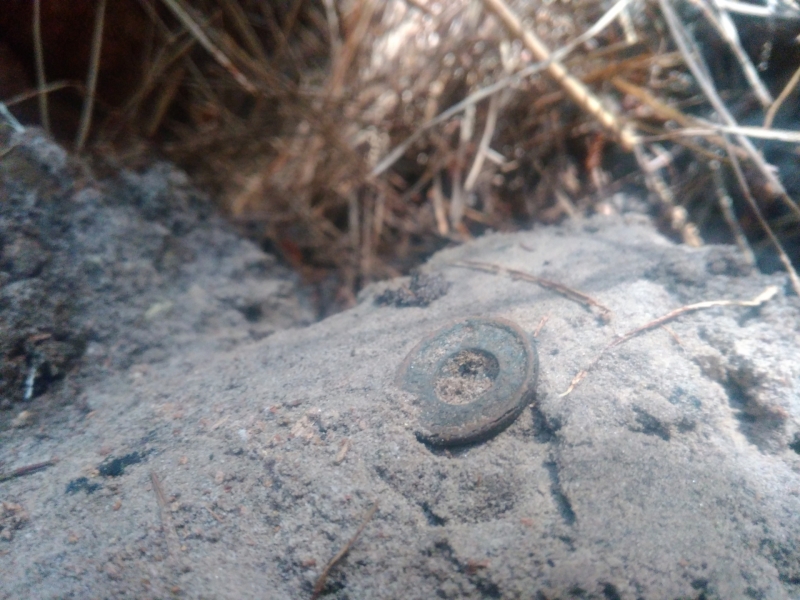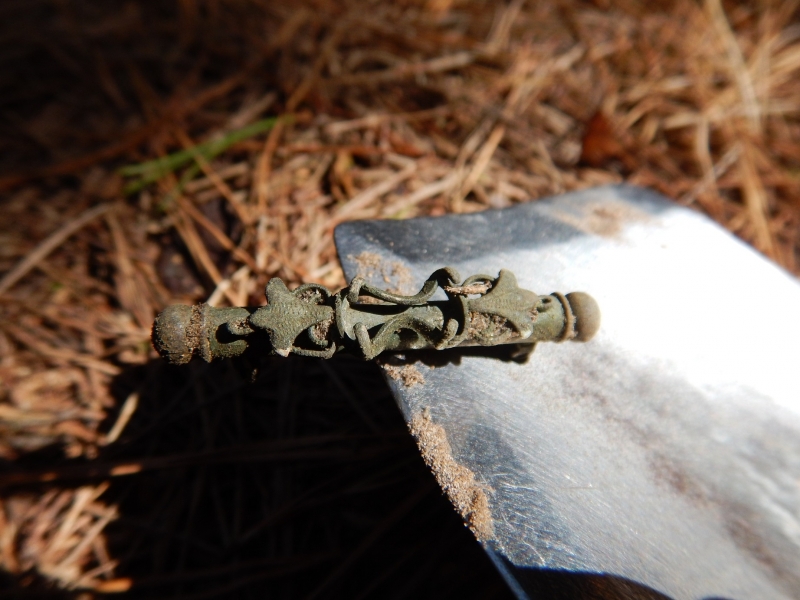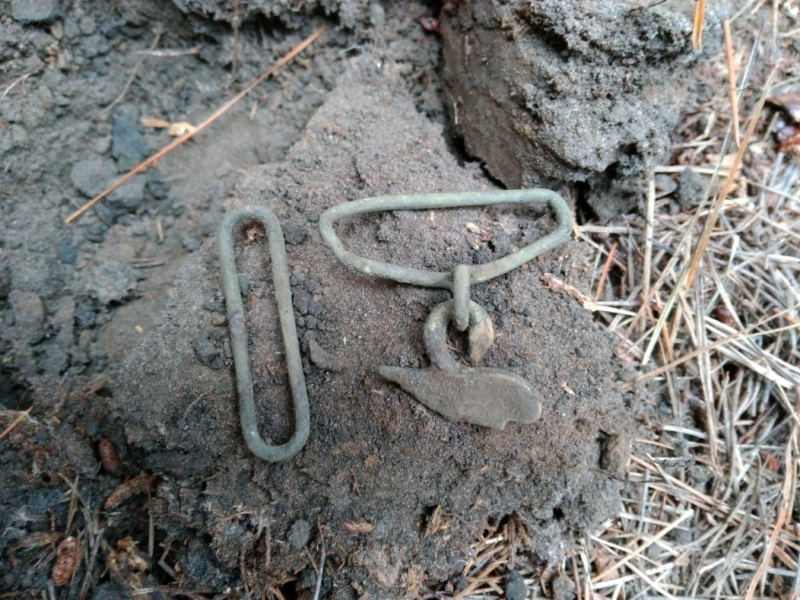-
Posts
213 -
Joined
-
Last visited
Content Type
Forums
Detector Prospector Home
Detector Database
Downloads
Everything posted by Goldpick
-
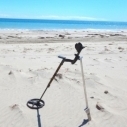
Late 1800's Ruins Bonanza
Goldpick replied to Goldpick's topic in Metal Detecting For Coins & Relics
Definitely clock parts, you also commonly come across the inner frames from them as well. Also think I came across an actual clock face with a wall pattern engraved on it. I really would like to find a complete silver fob watch, always seem to find just the outer bezels, or rusted inner workings - gold would be even better. -

Late 1800's Ruins Bonanza
Goldpick replied to Goldpick's topic in Metal Detecting For Coins & Relics
Hi Fred, yes it basically a purse. One side to pop in sovereigns and half sovereigns, and the other side for the smaller English silver coins. The higher quality ones come in silver. -

Late 1800's Ruins Bonanza
Goldpick replied to Goldpick's topic in Metal Detecting For Coins & Relics
Thanks Paulito, has been a fun site to detect, very easy digging too which helps with the target count at the end of the day. The only downside was the spider webs strung between every second tree, nothing like a full web plastering your face (and thinking where's the spider gone to). -
Hi folks, the last week or so I've been progressively detecting an area opposite some old ruins with the Deus, both on V3.2, and lately V4.0 (in Australia). Plenty of iron to deal with nearer to the ruins, not so bad in the area I'm detecting, just annoying small pieces of roofing iron that often sound a little tempting when at depth. Most of the coins found were Victorian era English pennies and half pennies, with the odd silver sixpence & threepence. Oldest coin so far was the 1860's, and the most out of place coin was an 1880 US Indian Head penny. Have also found eight very collectable 1800's dog registraton tags so far, and the coin total has just eclipsed 20. Yesterday turned up a surprise find, an English nickel plate Gold Sovereign holder, so there is the good possibility of finding some gold coins at thie site. Hope you enjoy the pics, and yes, all these finds were all unbelieveably from the same site - and still going!
-
Mmm, manufacturers that are on the leading edge - I'd have to say XP, as many manufacturers are trying emulate the success of the Deus, with some still trying to play catch up, and with varied rates of success. The other would have to be Minelab with its patented technologies, there's no getting around the fact that they have cornered the gold detecting market with innovative tech and well engineered detectors. As a whole, I think many of the manufacturers are starting to wake up to what the consumer wants or expects from a detector, vs what the manufacturer thinks is right for the consumer. This is reflected in by allowing testing and developmental input by the detecting community vs being soley done by in-house testers. Take Nokta/Makro as a prime example. My main detector for coin/relic detecting is of course the Deus, chosen to replace the Explorer SE Pro and Etrac due to both the ability, weight and excellent ergonomics, and being somewhat future proofed. My backups are the Makro Racer 2, Teknetics G2 and the F75 - jury is still out on the F75 at this stage. I rarely prospect, hence have a Garrett Infinium and White SPP gathering dust in my shed. The Infinium gets an odd run at the beach until I get sick of digging bobby pins and tent pegs. What should manufacturers incorporate into their detectors? Usual stuff - lack of weight, miniaturisation of the electronics, improved ergonomics, full wireless capability, ditch alkaline batteries and go Lithium polymer, and make detectors fully updatable by the end user. Generally speaking, make good use of current available technology on offer.
-

Coiltek Will Start Making Coils For White's
Goldpick replied to Ridge Runner's topic in White's Metal Detectors
All true, here's the relevant links: http://www.coiltek.com.au/coils/whites-tdi/ -
Apart from isolating the pinpointer response from ambient noise, it will also be very useful for those that indulge in evening/night or early morning detecting where one would prefer not to be disturbed, and with a preference to receive an audio report vs vibration from the pinpointer. Far from a gimmick, with many practical applications using a wireless setup. It would have been an added bonus for the Deus to display TID's and provide tone feedback on the target whilst pinpointing. I guess that idea would be something for XP to look at developing down the track - if the current hardware can support such a function.
-

Apprehensive About Digging
Goldpick replied to usaflaginmaine's topic in Metal Detecting For Coins & Relics
I also reverted to night detecting in some areas to avoid over zealous locals with no clue. Don't use a torch, just the backlit screen of the Deus and the light from the pinpointer - your eyes do adjust to the dark, using a torch makes things worst again (and attracts unwanted attention). Sad that things have come to the point of detecting in the dark in some areas, though as per a recent daytime park hunt, we were reported on 5 seperate occasions by locals for "digging up" a park. As a result the local council inspector paid us a visit, and quite frankly he didn't know what all the fuss was about. There was clearly no evidence of detector holes (we excavate flaps, not holes), and he was actually of the belief that we should be able to practice our hobby just as anyone else would in a public park. I thought I might add to the conversation to the inspector that I had been night detecting the park for the last year and a half, no one had a clue or could see evidence that I had even been there, just the way I like it. -

Apprehensive About Digging
Goldpick replied to usaflaginmaine's topic in Metal Detecting For Coins & Relics
Practice at home until you are confident that you can extract a target with minimal or no sign of ever being there. Don't take shovels or large digging implements into public parks, that will be the first thing that will make locals and authorities sit up and take notice (for all the wrong reasons). If the ground is too hard or too dry, don't attempt to dig plugs as it will simply leave a mess and most likely leave dead grass on your plug/flap. Find a scrappier looking area to start off with vs a neatly manicured park, if you do inadvertently leave a sign of being there, it will be less noticed or lesser of a concern. All the best with your detecting. -

What Pinpointer Do You Use?
Goldpick replied to usaflaginmaine's topic in Metal Detector Advice & Comparisons
The TRX is meant to be waterproof, rated to IP68 the same as the Garrett Carrot. Personally I use both, though prefer the audio, brighter LED, simple to navigate settings and larger speaker holes on the carrot (easier to clean the mud out of). The biggest disappointment on the TRX was the very dim LED and low audio levels, requiring the removal of headphones just to hear it. Making things worse, the small speaker holes are prone to clogging, and can be a pain to clean out. A couple of the features I do like on the TRX include the dual usage of 9v and AA batteries, and replaceable outer shell (on my second one). Being able to detect along the full length of the Garrett's shaft can be a blessing for some or a curse for others, especially if you have multiple targets in the same hole, or in the sidewall of the hole. The TRX will actually pick up targets on the upper end of the shaft, probably not an intended function, though it can catch you out at times if you have a targets on both the top/bottom of the hole. If I had to chose again between the two, the Garrett would be my choice. Pretty hard to fault it after 6 months of mud, water and abuse, just a more well rounded product. -

Makro Wireless Headphones Not Pairing
Goldpick replied to usaflaginmaine's topic in Nokta / Makro Metal Detectors
My first set of wireless headphones for the Racer 2 paired up pretty much straight out of the box. The second set I received with the all or nothing volume issues resolved did not pair up straight away. The step that made the difference was pressing the large button with the white dot on the side of the headset to change frequency, though you may have to remove the dongle and power up the Racer again on each frequency change to make it happen. My Racer 2 now pairs up straight away without issue. -

Need A Little Help On New Whites Pinpointer
Goldpick replied to tvanwho's topic in White's Metal Detectors
For me the TRX sensitivity setting 4 is unusable, 3 is borderline but still prone to falsing, and 2 is probably the most stable all-round setting. Both My Garrett AT Carrot and Minelab Profind also require retuning on basaltic or mineralised soils, otherwise they will suffer the same instability as with the TRX (profind put to ground on startup). In my experience, the only pinpointer I've owned that runs dead quiet on such ground is the Deteknix PI X-pointer, although it doesn't quite offer the same sensitivity to small targets, nor have the battery life of the more common VLF pinpointers. It can also have crosstalk issues with certain detectors being PI. Not sure what the newer units are like not having used them. As for crossplay between VLF pinpointers and your chosen detector, it all depends on what combo you have. My TRX seemed fine with most of my detectors, whereas the Garrett AT will send pulses through my Deus if too close to the coil, though nothing drastic and certainly manageable. The coil should be kept at least a couple of feet away during recovery, I would expect most pinpointers would set off the detector if only held a foot away from the coil - some more than others. If you are unsure on whether your chosen detector will play ball with a particular pinpointer, if possible, it might pay to try before you buy to make a more informed purchase. -
I am wondering whether the proposed wireless pinpointer for the Deus will be like your typical non-discriminating unit, or whether it will be another coil in its own right with full discrimination capability and control via the remote. Say a little like the Sunray probes, just a wireless version. That would be excellent for locating non-ferrous targets in a hole containing many other ferrous targets, and speed up the whole recovery process. The Minelab Pro-find is much like your GPZ Condor, can't get it anywhere near the Deus without copping an earful of noise.
-
I received the new Racer 2 wireless headphones today, and what was mentioned above is indeed the case. Quarter turn on the detector volume control gets nothing but silence, and when the volume does eventually kick in, it is just bearable. Anything above quarter turn is ridiculously loud, it's either all or nothing so to speak. It seems the headphones/dongle are not calibrated to the detector volume control properly, or something similar. My local dealer has contacted Makro to quiz them over the issue. Other than that, they are very comfortable with no noticable lag, the audio is crisp and clear, and they are very easy to pair up with the detector. I do feel that these sorts of issues can be easily avoided through rigorous quality control, that means testing each unit prior to distribution abroad. Yes it can incur additional costs for the manufacturer, though I would have thought trying to resolve an issue after the fact would cost a hell of a lot more, both financially and also to their reputation. Anyway, hopefully the issue lies with the dongle, and they can just ship out recalibrated units to change out with the current ones. Will keep you posted.
-

Golden Mask Universal Telescopic Handle
Goldpick replied to Steve Herschbach's topic in Metal Detector Advice & Comparisons
Thanks for the review Steve, I've been pondering over making a purchase for one of these, more for the heavier 13x11" coil than in anticipation of the new V4.0 coil. There is also the option to purchase just the top section of the Deus shaft minus the lower rod (XP Deus S Lite telescopic shaft), which does make it more affordable. It''s often advertised on French ebay stores for around $180 US incl shipping. Considering all Deus coils are normally supplied with a lower rod and mounting hardware, there's probably no real need to go to the added expense of buying the full Deus shaft assembly. The MarMD universal shaft assembly which you previously posted might also be a good alternative. Although it is not advertised as being suitable for the Deus, the fact that it can be used with every other XP Detector in the range which uses the Deus shaft, you would think the Deus coils should be a straight swap. I'm sure you could also jury rig a mount for the main control box on this shaft with some creative thinking. So many options! Cheers. -

How Minelab Designs Metal Detectors
Goldpick replied to Steve Herschbach's topic in Minelab Metal Detectors
True that Minelab tends to compete with itself at times, still wondering whether the X-terra 305 was dropped from their lineup to push new starters to the hobby into purchasing from the flagging Go-Find range. Pity, as the 305 is a much more capable and flexible VLF than the Go-Find 60, not to mention having multiple coil options available. I have to admit to purchasing a Go-Find 60 out of interests sake, whilst it is not a bad detector in principle, there is a big question over the longevity of the plastics and hardwired square concentric coil, especially on what happens once beyond the warranty period. Nice try by Minelab anyway, they certainly took a risk on the outlandish design compared to Garrett playing it safe on its latest generation of Ace detectors. I guess if it aint broke, don't fix it. Let's hope Minelab have a simple, lightweight, fast recovering FBS detector on the drawing board, I'd put my name down for one as a companion to the Deus. Surely they would sell like hotcakes. -

XP Deus Software Versions / Update History
Goldpick replied to Steve Herschbach's topic in XP Metal Detectors
Sorry Steve, wasn't meant to be seen as critical, just highlighting a difference in pricing as from what you would expect in the US, more due to our fluctuating dollar value if anything. Personally I don't have any huge issues with the Deus running the 13" coil, yes the lower shaft could be mounted a little further forward, though I still manage to remain relatively fatigue free after a day of detecting. I usually have a bad habit of not using the arm cuff strap on most of my detectors, but using the arm strap with the 13" coil really is a must for extended periods of detecting. There seems to be a few entrepreneurs out there making good use of their 3D printers, starting to see a few products including control box mounts, charging clips & coil mounts appearing on Ebay for Deus users. The wonders of technology never ceases to amaze me, with the capability to make many replacement parts via the home computer. The previously mentioned 13" coil adapter appears to be a 3D printer creation. -

XP Deus Software Versions / Update History
Goldpick replied to Steve Herschbach's topic in XP Metal Detectors
Cripes, the Deus coil pricing on our side of the world doesn't seem half as bad when comparing to local AT Pro prices. I purchased a Deus 13" coil for $550au direct from France, whilst our local price for an AT Pro International is around $1220au - a sizeable difference. An MX Sport here is close to $1500au, so the US dollar certainly isn't in our favour. Whilst the Deus coil costs do seem rather high, at least they already come packed with every conceivable feature and setting one could want in a good land based VLF detector, features that are often being drip fed by other manufacturers to their lineup to chase extra sales and to extend the life of certain models. It also does away with having to try and sell a superceded detector at a significant loss just to upgrade to a new model for a few additional features, often for the same combined price as a single Deus unit. Clever marketing, but also very clever engineering on XP's part. I think it was also mentioned that the wireless pinpointer for the Deus was going to be released prior to the V4.0 upgraded, so possibly something to keep an eye out for. -
Having the ability to fix bugs via updates has proved very handy on the Deus. Earlier in the year my WS4 headphones froze and became completely unresponsive for reasons unknown (XP had never come across such an issue). After contacting Francois directly at XP, she suggested I reload the V3.2 software onto the control unit, remote and coil via my laptop, and five minutes later everything was good to go. If it had been any other brand, no doubt it would have required everything to be sent to back to the manufacturer, or at best the local distributor for trouble shooting, repair or I am also looking forward to trying out the Racer 2 wireless headphones when they become available in June, has been a long time coming.
-

Pinpointer & Makro Racer Compatibility
Goldpick replied to Oro-Pepita's topic in Nokta / Makro Metal Detectors
Doubtful whether it is the Pro-find, as the coil circuit should disconnected when not in use. Are you carrying a mobile phone on your person by any chance, just going down the route of natural deduction to discount any other possibilities. -
Whites need to seriously think about applying a sticker onto the MXS to indicate whether it has been upgraded or not, and what what specific version is loaded, just as Garrett did in Oz with the Infinium upgrades several years ago. If manageable, maybe sticker in the battery compartment would suffice. It will save a lot of confusion for both new and second hand buyers when trying to identify which firmware package is loaded onto the detector, plus negate the requirement to contact Whites directly for matching of serial numbers. No doubt a paper receipt from the tech dept. will be easily lost or misplaced, not that it appears to hold much useful info for the owner/customer on the actual firmware version.
-

When Will The Nokta Impact Hit Market?
Goldpick replied to Ridge Runner's topic in Nokta / Makro Metal Detectors
Multi-tones or fulltones would be a welcome addition to the Impact, that would definitely spark interest from me. -
Hi John & Steve, to put the Deus coil price into context, it does essentially buy you four different detectors in the one package. It is also somewhat future proofed compare to other brands that constantly drip feed improvements, more than often requiring the purchase of a completely new detector to benefit from them. Despite its size, the Deus 11" coil has proved to be brilliant multi-purpose coil, even on some of the iron filled relic sites I am currently detecting. It is not uncommon to pull a repeatable clear non-ferrous target from a hole containing several square nails with this coil. Usually I don't even know they are there until I scan with the pinpointer, and more than often the non-ferrous item is the deepest target. As for the latter comment on sending the Deus back to XP for any possible software bugs, there should be no need. Any updates, improvements and most software debugging should be sorted out via downloads from your home pc. I recently had a bug with my WS4 backphones freezing, and after contacting XP directly regarding the issue, and they simply asked me to re-load the latest software. 5 minutes later the issue was sorted, and everything was functioning as per normal. Have a software bug on most other detectors, and it will most likely have you boxing up the detector to be shipped back to the manufacturer/dealer for evaluation and a lengthy wait. If any issues cannot be sorted via software downloads, XP's policy in my part of the world is to simply ship out a new replacement part/unit from local stock, vs making you wait for a return on your defective unit, you couldn't ask for more than that. As for the wait on v4.0 software, I'm certainly in no hurry. The Deus in its current format is still a benchmark for many other manufacturers to catch up on and emulate its success. Checkout my most recent find from an 1840's house site here in South Australia, an 1820's US Naval Dirk belt plate found in three seperate pieces. A long way from home!
-

Guess The Price of the GPZ 7000 ?
Goldpick replied to Sourdough Scott's topic in Minelab Metal Detectors
That is correct, $10700 au is now being listed by Australian dealers as the official price, delivery 1st March onwards.

